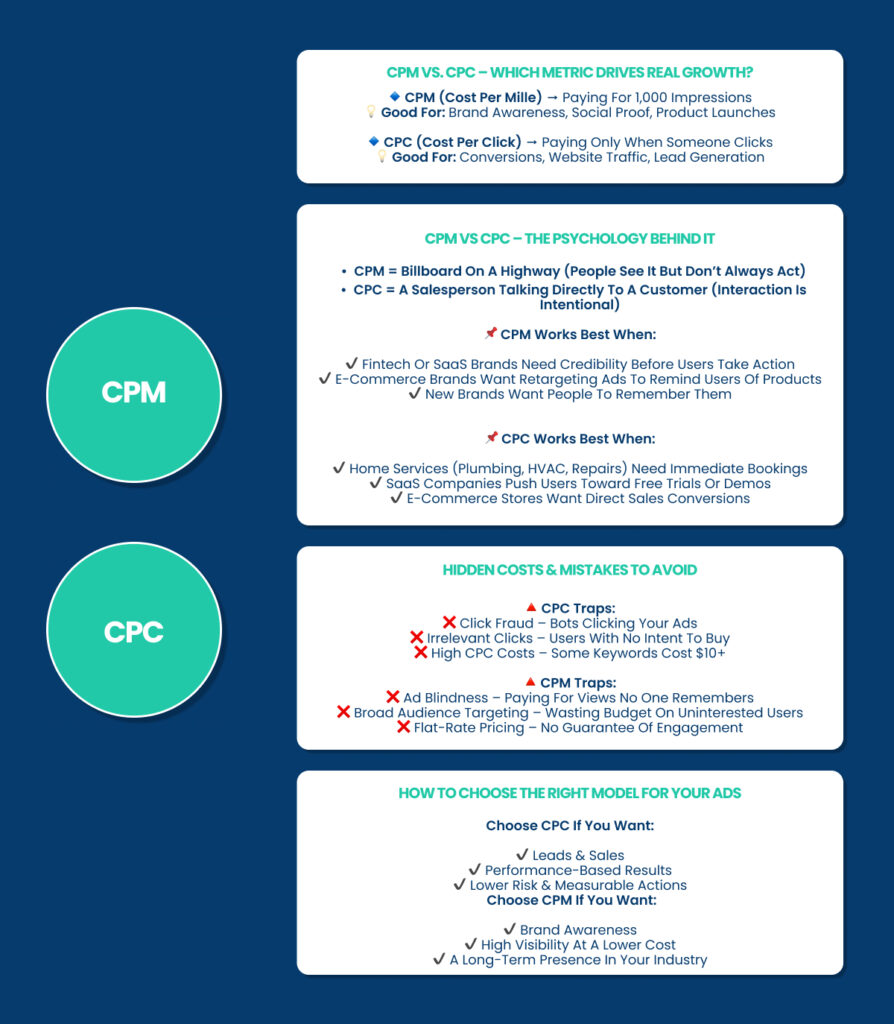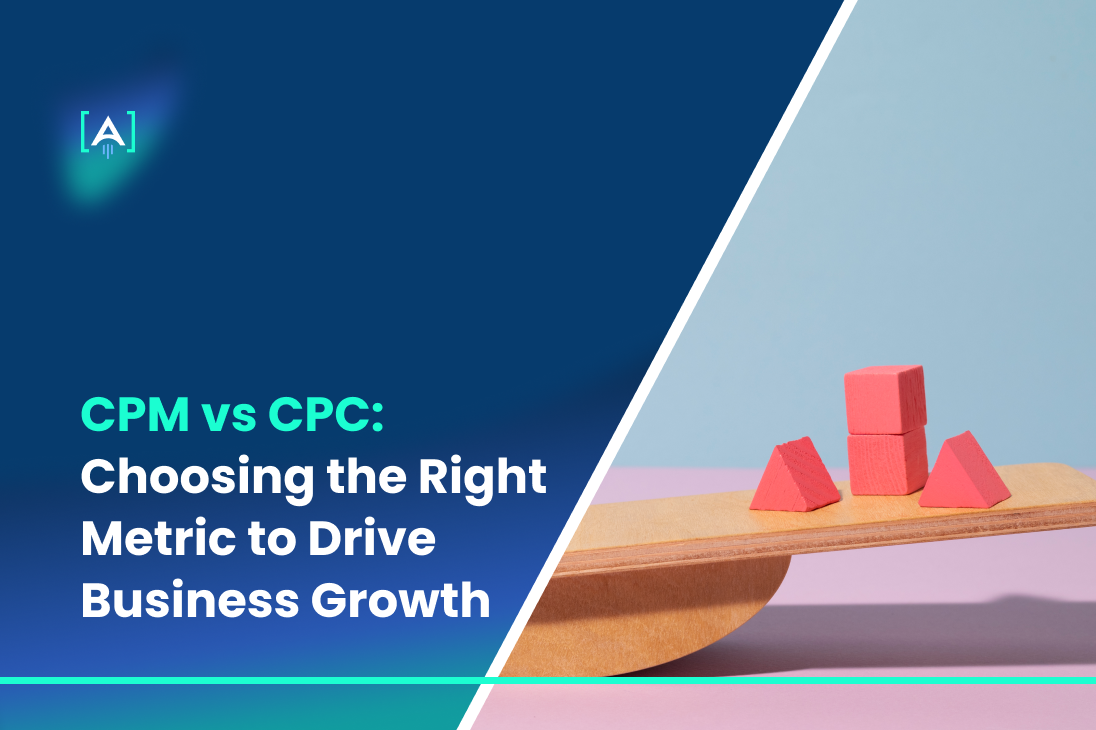Ever felt like you’re throwing marketing dollars into a black hole?
You’re seeing clicks, maybe even some likes, but is it actually moving your business forward?
The truth is, simply having a campaign isn’t enough.
You need to speak the language of metrics.
And when it comes to online advertising, two acronyms reign supreme: CPM and CPC.
But these aren’t just fancy terms. They’re the keys to unlocking real growth. Choosing the right one can be the difference between a marketing triumph and a costly flop.
Welcome to the CPM vs. CPC dilemma—one of the biggest decisions in digital advertising.
- CPM (Cost Per Mille) means you pay for impressions—your ad is seen, but will anyone engage?
- CPC (Cost Per Click) means you only pay when someone clicks—but clicks don’t always guarantee conversions.
So, which one is better for your business? Well, that depends on your goals, audience, and strategy. Consider also a CPM Calculator—a tool that helps you estimate how much exposure your ad budget can buy.
But before you start crunching numbers, let’s break it down further.
This guide will help you cut through the confusion, compare both models, and decide which one fuels your business growth.
CPM vs. CPC: The Marketing Duel You Can’t Ignore
Online advertising isn’t just about running ads—it’s about spending wisely.
You wouldn’t throw money at a billboard in the middle of nowhere, and you wouldn’t pay for clicks that never turn into customers. That’s where CPM (Cost Per Mille) and CPC (Cost Per Click) come in.

These two pricing models decide how you spend your budget and what you get in return. Choose wrong, and you could waste thousands. Choose right, and you could drive serious business growth.
What Are CPM and CPC Really? (And Why Should You Care?)
Not everyone speaks marketing jargon, but if you’re running ads, you need to know these two terms:
- CPM (Cost Per Mille): You’re paying for impressions—how many people see your ad.
- CPC (Cost Per Click): You’re paying only when someone clicks on your ad.
Think of it like this:
- CPM is like a billboard. You’re paying for visibility, whether people act on it or not.
- CPC is like a salesperson on commission. You only pay when someone interacts.
Why This Matters for Businesses
- SaaS companies focused on trials and sign-ups? CPC is your best friend. Paying per click helps ensure that only engaged users see your offer.
- Home service businesses (plumbers, electricians, etc.)? CPC helps drive direct leads like someone clicking to call for an emergency repair.
- E-commerce brands launching a new product? CPM builds awareness so customers recognize you when they’re ready to buy.
- Fintech apps trying to establish trust? CPM can introduce your brand to potential users before you shift to CPC for conversions.
The Psychology of CPM vs. CPC: What’s Happening in Users’ Minds?
Ever wonder why some ads get tons of clicks while others are just there?
It’s all about how people process advertising.
CPC: The Clicks-Mean-Interest Model
Source: Instapage
- A person who clicks on an ad is showing intent—they are curious, interested, or ready to act.
- SaaS companies rely on CPC for free trial sign-ups—they need users to engage and try their product.
- Home services ads with “Book Now” buttons? Clicks drive instant leads.
CPM: The Subconscious Brand Recall Model
- Even if people don’t click, repeated exposure helps plant your brand in their memory.
- Think fintech brands—you may not sign up for a banking app today, but after seeing their ad a dozen times, you start to trust them.
- E-commerce brands often use CPM for retargeting—showing you ads for products you browsed but didn’t buy.
Why CPM is Like a Billboard and CPC is Like a Sales Pitch
🔹 CPM (billboard): It’s about being seen—people don’t act immediately, but they remember.
🔹 CPC (sales pitch): You’re talking to someone who is already interested and just needs a push.
The key is knowing what your audience is ready for—brand awareness or immediate action.
CPM or CPC? The Million-Dollar Question
Show Me the Money: Which Model Gives the Best ROI?
If every dollar matters, choosing the right metric can make or break your ad campaign.
Real example:
- CPC for a home services company: Running ads targeting homeowners searching for “emergency plumbing” at $4 per click. 10 clicks = 3 paying customers = high ROI.
- CPM for an e-commerce brand: Paying $5 per 1,000 impressions. Even with 50,000 impressions, if the engagement rate is low, ROI might take longer.
The Hidden Costs No One Talks About
Before you throw money into ads, watch out for these budget killers:
CPC Trap:
- Click fraud (bots clicking on your ads).
- Irrelevant clicks (people who click but never buy).
- High competition = expensive keywords.
CPM Trap:
- Paying for impressions that no one actually sees (ad blindness).
- Getting views from the wrong audience (wasted budget).
- Flat-rate CPM pricing that doesn’t guarantee performance.
Want to maximize ROI? Combine smart targeting + ad testing + performance tracking.
When to Use CPM vs. CPC: The Ultimate Decision Guide
“I Want More Clicks” → Choose CPC
Best for:
✔ Lead generation
✔ E-commerce sales
✔ SaaS sign-ups
How to optimize:
- Target high-intent keywords.
- Use strong CTA buttons (“Try Free,” “Book Now,” “Get a Quote”).
- A/B test different ad creatives to improve conversion rates.
“I Want to Be Seen Everywhere” → Choose CPM
Best for:
✔ Brand awareness
✔ Product launches
✔ Retargeting campaigns
How to get the best rates:
- Narrow your audience—don’t show ads to everyone.
- Use eye-catching visuals to combat ad fatigue.
- Run ads on high-viewability placements (above-the-fold banners, in-feed social ads).
What If I Want Both? The Hybrid Model
Smart businesses don’t pick just one—they mix both for maximum impact.
Example: A fintech startup wants to drive app installs.
- CPM for awareness: Introduce the brand with eye-catching display ads.
- CPC for conversions: Retarget users who engage and drive app sign-ups.
Best practice: Start with CPM to build trust, then switch to CPC when users are ready to act.
Winning the CPC vs. CPM Game: Advanced Strategies
Advertising isn’t just about running ads—it’s about running profitable ads.
No one wants to throw money at campaigns that don’t convert.
Whether you’re paying per click (CPC) or per impression (CPM), small mistakes in bidding, tracking, and audience targeting can drain your budget fast. But smart advertisers know how to use data, AI, and testing to stretch every dollar.
AI vs. Manual Bidding: Which One Should You Trust?
Automated bidding sounds great—AI does the work, optimizes results, and lowers costs.
But is it always the best option?
- AI-powered bidding works well when there’s enough data to make smart decisions.
- Manual bidding is often better for smaller campaigns or niche markets where AI lacks enough history to optimize properly.
- Best approach? Start manually, set max bid limits, then let AI take over when you have solid conversion data.
Biggest Mistakes Businesses Make with CPC & CPM Bidding
- Setting bids too high without testing – Don’t assume a high bid means better results. Test with smaller budgets first.
- Ignoring ad placement costs – Some sites charge more for above-the-fold placements, which impact CPM but might not be worth it.
- Forgetting to track real conversions – Clicks (CPC) don’t matter if they don’t lead to sales. Tie bids to conversion rates, not just impressions or clicks.
Pro Tip: Calculate your CPM using the CPM formula to see if your impressions are cost-effective:
Compare this to how many actual leads or sales those impressions drive before deciding whether to increase or decrease your bids.
Turbocharging Your Ad Performance with Data
Ads that aren’t measured aren’t improved.
The difference between wasting money and scaling up profitably comes down to how you track and tweak your campaigns.
Source: Invoca
Why CTR (Click-Through Rate) and Quality Score Matter More Than You Think
- A high CTR (click-through rate) means your ad is relevant. The higher the CTR, the lower your CPC.
- Quality Score (Google Ads) or Relevance Score (Meta Ads) affects how much you pay per click or per 1,000 views.
- Low CTR = More expensive CPC bids. High CTR = Lower CPC bids & better ad placements.
How to Use Heatmaps & Session Recordings for Smarter Ad Decisions
Numbers tell you what’s happening, but heatmaps show you why.
Heatmaps help track:
- Where users click after landing on your page
- If they scroll far enough to see key content
- Which areas attract attention and which are ignored
Example: A fintech company notices that users click on its ad but leave immediately.
Solution: A heatmap shows that people expect instant loan quotes but have to fill out too many forms. Fixing this lowers bounce rates and increases conversions. Test, tweak, and adjust based on real user behavior—not just click numbers.
The Future of CPM & CPC: What’s Changing?
The way ads are bought, sold, and measured is shifting fast.
If you don’t keep up, you could end up paying more for worse results.
“Cookies Are Dying” – What This Means for Your Ad Metrics
For years, advertisers relied on cookies to track users, target ads, and improve results.
But third-party cookies are disappearing, and that’s changing everything.
- CPM-based campaigns may become less effective without detailed audience tracking.
- CPC costs could rise as advertisers compete for fewer precisely targeted users.
- AI-powered audience targeting is replacing cookies—using behavioral patterns instead of cookie tracking.
How to Adapt:
- Use first-party data (emails, app data, surveys) to build audiences.
- Focus on content-driven retargeting instead of relying on past user behavior alone.
- Keep an eye on CPM rates—a rise in CPM without improved engagement could signal wasted spend.
The Social Media Ad Evolution: Who Wins, CPM or CPC?
Social media platforms aren’t playing fair with ad pricing.
Source: Exploding Topics
Algorithms constantly change, shifting the balance between CPM-based visibility and CPC-driven engagement.
Who’s Pushing What?
Facebook & Instagram:
- CPM is higher than before due to more advertisers entering the space.
- CPC costs fluctuate depending on engagement rates—better creative = lower costs.
TikTok Ads:
- CPM is cheaper than Instagram, but click-through rates can be unpredictable.
- Works well for awareness but not always for conversions.
LinkedIn Ads:
- CPC is high (sometimes $5-$10 per click), but leads are often high-value (especially for B2B and SaaS).
- CPM makes sense only for broad branding efforts.
So, What’s the Right Choice? It Depends on What You Want to Win
There’s no universal answer to the CPM vs. CPC debate—because winning in advertising isn’t about picking sides. It’s about playing smart. Want more clicks and conversions? Go for CPC. Need brand awareness and visibility? CPM is your best bet.
[A] Growth Agency will help you navigate the choice strategically. We don’t believe in one-size-fits-all solutions.
What works for an eCommerce brand might not work for a SaaS company, and what drives results for a home services business may not be the best approach for Fintech advertising.
Instead of blindly choosing CPM or CPC, we focus on data-driven testing, audience insights, and campaign optimization to make sure you’re not just spending—but actually growing.
Excellence is our standard. At the end of the day, success isn’t about how you pay—it’s about what you get back.

